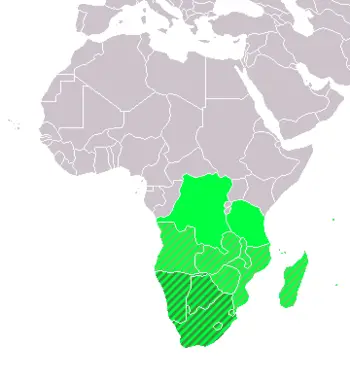Southern Africa
- This article concerns the region in Africa. For the present-day country in this region, see South Africa; for the former country, see South African Republic.
Southern Africa is the southernmost region of the African continent, variably defined by geography or geopolitics. Within the region are numerous territories – including the Republic of South Africa, a successor country to the South African Republic (Transvaal Republic).
Definitions and usage
In the UN scheme of geographic regions, five countries constitute Southern Africa:
The region is often reckoned to include other territories:
- Angola – also included in Central Africa
- Mozambique and Madagascar – also included in Eastern Africa
- Malawi, Zambia, and Zimbabwe – sometimes included in Southern Africa and formerly of the Central African Federation
- Comoros, Mauritius, Seychelles, Mayotte, and Réunion – small island territories in the Indian Ocean east of the African mainland
The Democratic Republic of the Congo and Tanzania, though more commonly reckoned in Central and Eastern Africa respectively, are occasionally included in Southern Africa. Apropos, the Southern African Development Community (SADC) was established in 1980 to facilitate co-operation in the region, which includes all of the above except Comoros (totalling 15 members).
The Southern African Customs Union (SACU), created in 1969, comprises the five countries in the UN subregion of Southern Africa.
The term Southern Africa was also used to refer to South Africa and the "independent" Bantustans that were re-incorporated into South Africa following the end of Apartheid in 1994. [citation needed]
Another geographic delineation for the region is the portion of Africa south of the Cunene and Zambezi rivers – that is, South Africa, Lesotho, Swaziland, Namibia, Botswana, Zimbabwe and the southern half of Mozambique. This definition is most commonly used in South Africa. [citation needed]
Geography
The terrain of Southern Africa is varied, ranging from forest and grasslands to deserts. The region has both low-lying coastal areas, and mountains.
In terms of natural resources, the region has the world's largest resources of platinum and the platinum group elements, chromium, vanadium, and cobalt, as well as uranium, gold, titanium, iron and diamonds.
Economy
The region is distinct from the rest of Africa, with some of its main exports including platinum, diamonds, gold, and uranium, but it is similar in that it shares some of the problems of the rest of the continent. While colonialism has left its mark on the development over the course of history, today poverty, corruption, and HIV/AIDS are some of the biggest factors impeding economic growth. The pursuit of economic and political stability is an important part of the region's goals, as demonstrated by the SADC.
Environmental factors
The region has a broad diversity of ecoregions including grassland, bushveld, karoo, savanna and riparian zones. Even though considerable disturbance has occurred in some regions from habitat loss due to human overpopulation, there remain significant numbers of various wildlife species, including White Rhino, lion, leopard, impala, kudu, Blue Wildebeest, Vervet monkey and elephant.
Culture and peoples
Southern Africa is home to many cultures and peoples. African tribes of the area include the Zulu, Xhosa, Ndebele, Tswana, Pedi, Venda, Sotho, San, Tsonga and Shona people (though this list is far from exhaustive). The process of colonization and settling resulted in a significant population of European and Indian descent in many southern African countries.
| Regions of the world | |||||||||||||||||||||||||
|---|---|---|---|---|---|---|---|---|---|---|---|---|---|---|---|---|---|---|---|---|---|---|---|---|---|
|
| ||||||||||||||||||||||||
| See also Continents of the world | |||||||||||||||||||||||||
Credits
New World Encyclopedia writers and editors rewrote and completed the Wikipedia article in accordance with New World Encyclopedia standards. This article abides by terms of the Creative Commons CC-by-sa 3.0 License (CC-by-sa), which may be used and disseminated with proper attribution. Credit is due under the terms of this license that can reference both the New World Encyclopedia contributors and the selfless volunteer contributors of the Wikimedia Foundation. To cite this article click here for a list of acceptable citing formats.The history of earlier contributions by wikipedians is accessible to researchers here:
The history of this article since it was imported to New World Encyclopedia:
Note: Some restrictions may apply to use of individual images which are separately licensed.
